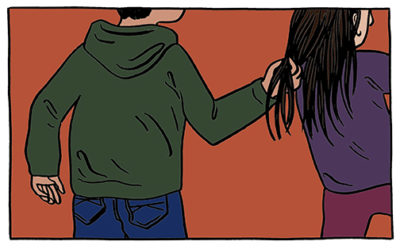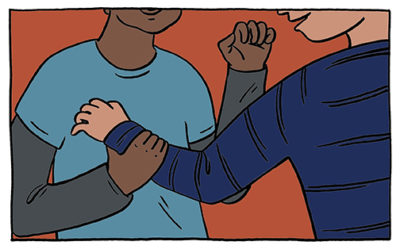Physical touch between sixth graders is not uncommon – they’re all over each other, and mostly in a friendly, playful way. I recently instituted a “one person per chair” rule in my classroom, as a trend towards seat-sharing started taking root. Some of these instances were clearly flirtatious, but more often they were between friends, and much harder to classify. Early middle school is a lot like early elementary developmentally – they’re handsy, affectionate, full of emotions.
But touch gets complicated in and out of the classroom, and the #metoo movement has brought up countless discussions about the nuances of consent. How do I teach students, particularly boys, about responsible, caring ways to interact physically with others?
Last week I heard a commotion: my 8th grade Teaching Assistant was demanding that a student – let’s call him “Sam” – apologize to a nearby female student, “Elena.” He had pulled her hair, and my T.A. was reacting loudly and vehemently, while Elena walked away from the situation. Not surprisingly, this all happened right as the bell rang. I talked with my T.A. to learn what they witnessed, and I talked with Sam privately (in the hall during class) the next day. He said they were just playing around, that Elena didn’t mind. “How do you know she didn’t mind?” I asked. His response: “We’re friends.”
I tried, strategically, to word my response in a way that didn’t put him in a defensive position that would shut down the possibility for learning. “Sam, I’ve known you for a few months, and I’ve seen you be a great friend. But even if you mean something playfully, it might feel like a violation of personal space to someone else.” He agreed, promised to talk with Elena, moved on. My T.A. was satisfied that I took it seriously.

But then, a few days later, I noticed Sam tickling a male student at his table. This time I got more to the point: “Sam, did you ask for his consent before touching him?” The other student giggled and said, “It’s ok – we’re friends!” I snapped to my senses and pointed out that tickling doesn’t belong in a classroom anyway. They were both smiling and participating – does that count as consent?
In cases of sexual touch, Washington State law is clear around Standards of Conduct for Students: “…consent must be clear, knowing, and voluntary. Anything less is equivalent to a ‘no’…Consent is active; silence or passivity is not consent.”
The wording leaves no room for nuance, and rightly so: anything short of an explicit “yes” is equivalent to non-consent. As early adolescents explore all kinds of touch, I’m struggling to help shape students that won’t be the next generation of sexual harassers…or worse. There are many opportunities for social development in the art classroom while students collaborate, share experiences from their lives, analyze artwork and consider bias and privilege. Social learning happens when they’re in a bad mood, and trying to share tape or scissors! As they interact and learn about the impact of their behaviors on others, how do I teach them to really listen when others are communicating boundaries? Sometimes boundaries are communicated with a smile, between “friends,” because the other person is so uncomfortable that it is too hard to say “no” with a serious tone. Or the social capital that would be lost with firm “no” keeps a girl silent.

In “Do You Think I’m Pretty: Consent as Community,” Reina Gattuso writes, “We tend to talk about consent ‘as an individual process,’ not asking ‘What kinds of power are operating in this situation?’ but only ‘Did you or did you not say yes?”
That resonates for me as key to my students’ understanding of respectful, consensual, GOOD touch now and in their futures: What kinds of power are operating in this situation? What power do you have in relation to the person you want to touch?
I don’t plan to center these questions as the learning target of a unit or lesson plan. But I will try to incorporate these questions as I help students navigate social relationships in class. The power relationship aspect is connected to our class discussions about cultural appropriation in art, and it’s the reason that a boy can’t pull a girl’s hair without her abundant, enthusiastic “yes.” Even then, he needs to watch for non-verbal cues that she wants him to stop. (And no, hair pulling doesn’t belong in class anyways.)
Even at age 12, there is an imbalance of power between boys and girls, and I won’t have boys assuming “yes” or even hearing “yes” when a girl means “no.” Social norms around consent continue to change. As our understanding grows regarding the vast ways that privilege and power shape daily life between us, I hope our boys get better and better at physical touch that empowers others. And stick to one person per seat in class!
Hi Robyn,
I went to the source-my own middle school son. I asked him if he would tickle a guy friend in class. “Ya, we would joke around. Sure. ”
I asked if he would tickle a specific girl he knows. He answered, “No!” I was surprised…
“Why not?” I asked.
“Well, she is the kind of person who would punch you if you tickled her!” I know the girl. Good point son.
I asked if he would tickle any other girl in class. He answered that he would not because, “…something tells me not to. I don’t know what it is. But, I just wouldn’t. It is just not okay like joking with your guy friends.”
I looked puzzled. He shrugged and said, “May I go now? There is a problem with the vacuum-it sucked up something and now it won’t start. I am in the middle of taking it apart.”
I am going to do some more investigating into what that “something” is. For now, I have a broken vacuum to attend to…
Thanks for your post,
Gretchen
Thanks for your on-the-ground research, Gretchen!
My colleagues and I have been grappling all year with helping our middle school students navigate appropriate/inappropriate/consensual/unwanted touch. I really appreciate the examples you gave from your classroom and how you and your students responded. It’s such a complex issue, and attending to it is one of the most important things we can do in schools.
Thank you for this post, Robyn. I teach grades 7-12, and those 7th-grade boys and girls are still working out what is appropriate playfulness in the hall and in the classroom. Touching, playing with one another’s hair, and rough housing are constant management issues. I’m always coaching them to keep their hands to themselves if they don’t have permission. I hadn’t quite equated this work to the #metoo movement, but it totally makes sense. These kids live in a changing world. They need to understand the consequences of abuse of power, and to do that they need to understand the power that they have.